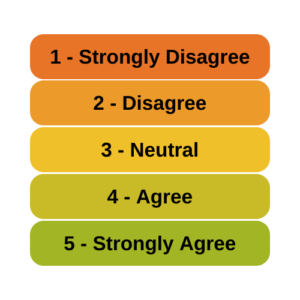Are Scores From a Likert Scale Considered Continuous
A very common question is whether it is legitimate to use Likert scale data in parametric statistical procedures that  require interval data, such as Linear Regression, ANOVA, and Factor Analysis. A typical Likert scale item has 5 to 11 points that indicate the degree of agreement with a statement, such as 1=Strongly Disgree to 5=Strongly Agree. It can be a 1 to 5 scale, 0 to 10, etc.
require interval data, such as Linear Regression, ANOVA, and Factor Analysis. A typical Likert scale item has 5 to 11 points that indicate the degree of agreement with a statement, such as 1=Strongly Disgree to 5=Strongly Agree. It can be a 1 to 5 scale, 0 to 10, etc.
The Debate
The issue is that despite having numbers, a Likert scale item is in fact a set of ordered categories.
One camp maintains that as ordered categories, the intervals between the scale values are not equal. Any mean, correlation, or other numerical operation applied to them is invalid. Only nonparametic statistics or other analyses for ordered data are appropriate for Likert scale data (i.e. Jamieson, 2004).
The other camp maintains that yes, technically the Likert scale item is ordered. Even so parametric tests can be valid in some situations. For example, Lubke & Muthen (2004) found that it is possible to find true parameter values in factor analysis with Likert scale data, if assumptions about skewness, number of categories, etc., were met. Likewise, Glass et al. (1972) found that F tests in ANOVA could return accurate p-values on Likert items under certain conditions.
Meanwhile, the debate rages on.
Recommendations
So, what is a researcher with integrity supposed to do? In the absence of a definitive answer, these are my recommendations:
- Understand the difference between a Likert type item and a Likert Scale. A true Likert scale, as Likert defined it, is made up of many items, which all measure the same attitude. But many people use the term Likert Scale to refer to a single item. Confusion about what a Likert Scale is, no doubt, has contributed to the debate.
- Proceed with caution. Research the consequences of using your procedure on Likert scale data from your study design. The fact that everyone uses it is not sufficient justification. There are some circumstances and procedures for which it is more egregious than others.
- At the very least, insist that the item have at least 5 points (7 is better), that the underlying concept be continuous, and that there be some indication that the intervals between points are approximately equal. Make sure other assumptions (e.g. normality & equal variance of residuals, etc.) be met.
- When you can, run the nonparametric equivalent to your test. If you get the same results, you can be confident about your conclusions.
- If you do choose to use Likert data in a parametric procedure, make sure you have strong results before making claims. Use a more stringent alpha level, like .01 or even .005, instead of .05. If you have p-values of .001 or .45, it's pretty clear what the result is, even if parameter estimates are slightly biased. It's when p-values are close to .05 that the effect of bending assumptions is unclear.
- Consider the consequences of reporting inaccurate results. Will anyone ever read your paper? Will your research be published? Will others use it to shape public policy or affect practices? The answers to these questions can inform the seriousness of potential problems.
References:
Carifio, J. & Perla, R. (2007). Ten Common Misunderstandings, Misconceptions, Persistent Myths and Urban Legends about Likert Scales and Likert Response Formats and their Antidotes. Journal of Social Sciences, 2, 106-116. http://thescipub.com/PDF/jssp.2007.106.116.pdf
Glass, Peckham, and Sanders (1972). Consequences of failure to meet assumptions underlying the analyses of variance and covariance, Review of Educational Research, 42, 237-288.
Jamieson, S. (2004). Likert scales: how to (ab)use them. Medical Education, 38, 1212-1218.
Lubke, Gitta H.; Muthen, Bengt O. (2004). Applying Multigroup Confirmatory Factor Models for Continuous Outcomes to Likert Scale Data Complicates Meaningful Group Comparisons. Structural Equation Modeling, 11, 514-534.
Source: https://www.theanalysisfactor.com/can-likert-scale-data-ever-be-continuous/
0 Response to "Are Scores From a Likert Scale Considered Continuous"
Post a Comment